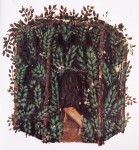
American Jewish World Service does important work, so when a site they built for educators and learners to access Jewish sourcetexts on social justice and other important activities disappeared overnight due to what appeared to be a domain registration lapse, I was motivated to write an essay on how organizations can appreciate their websites as more than “proprietary and Copyrighted marketing assets to better leverage their brand.” eJewishPhilanthropy, a well-read blog popular among Jewish professionals published it this morning. Here’s a snippet: . . . → Continue reading: Teach me your Open Source Torah, on one foot

Last year, I was interviewed by Alan Jacobs for the Atlantic Magazine on the potential and promise of an open source Judaism. This year I was privileged to write an essay for the Sova Project, a project that is considering the structures and processes of a sustainable society through the lens of biblical, prophetic, and rabbinic Jewish values and practices. In the essay I try to pose many of the same concerns from the perspective of community professionals: scholars, artists, and educators: “Those of us who make a living as crafters, educators, and servants of the Jewish community: how do we feel about sharing our work? I mean, really sharing? When, in working with Torah, I create a lesson plan or feel like I have some brilliant insight or analysis or make a translation, how do I give it, release it to the world at large so that my work can spread through adoption, adaptation, redistribution (and attribution)? Further, what are my anxieties and vulnerabilities in sharing my Torah? What honestly are my desires, aspirations, and needs? How, through my method of sharing, can I satisfy and reconcile these concerns?” In wrestling with these questions, I wanted to bring attention to an important orientation that guided Talmudic discourse in Torah — that of dimus parrhesia, a Greek term for a cultivated attitude towards sharing ideas, freely and openly. . . . → Continue reading: Making oneself into a Maqom Hefker (an ownerless place): On the Economy of Sharing Torah, Dimus Parrhesia (freely and openly)

A Midrash of the Jews of Yemen dating from the 13th century provides the following explanation for the mystery of the four-branched shin. There is one “head” for each of the following facets: cogitation, imagination, memory, and estimation.[ref]paraphrasing Midrash haBeur, translated in Yemenite Midrash: Philosophical Commentaries on the Torah, edited by Y. Tzvi Langermann, p. 242.[/ref] Additionally, the midrash provides the following astrological explanation for the three and the four branched shin appearing together on the tefillin shel rosh: together their seven heads make up the seven visible wandering stars (i.e., the planets), whose celestial powers in Jewish cosmology must have one root in the mind of G!d. . . . → Continue reading: All Streams, One Source: Shesha and the Mystery of the Four-headed Shin
Nigel Savage made public this week his reply to Ben Dreyfus[ref]For more on this, see here, here, and here[/ref] and others concerning Ḥazon’s orthography of ט״וּ בִּשְׁבַט as Tu B’Shvat rather than Tu biShvat. Given the seriousness of the environmental and food justice issues that Tu biShvat gives voice to, it’s important to recognize that this earnest if seemingly comical debate isn’t really about romanization of Hebrew anymore. It’s a question about Siaḥ (שִׂיחַ — discourse), the roles of Jewish education, and the goals of Jewish educators. . . . → Continue reading: “Tu biShvat” vs. “Tu b’Shvat”: Orthography and Presumptions of Authority in Jewish Environmental Education

Petru Moldovan writes, “Idel notices that in “Ghet ha-Îemot,” Abulafia had used for the first time the gematria combination: Elohim = ha-Teva. To Abulafia, Elohim is the act of Creation, and not its agent, as this name is the same with nature, and the gematria combination should not be understood as a simple linguistic pun, but as a way of considering the identity of nature with the divine, just as Maimonides had suggested it in the “Guide.” . . . → Continue reading: Great Nature and the Gematria of Elohim

Jeff Anshalem writes, “On Shabbat Ḥol Hamoed Sukkot we read of the giving of the Ten Commandments on Mt. Sinai, seemingly a strange choice for Sukkot, but the Maor VeShamesh explains what’s common to both: unity. Unity between us, symbolized by the joining together of the Four Species (Vayikra Rabbah 30:12), evokes unity between us and G!d.” . . . → Continue reading: The Sign of the Twins: On the Reconciliation of the Divine with its Likeness

One of the most delightful things I learned about Judaism growing up was that rabbinic Judaism had not one, but four new year holidays (according to the Mishnah Seder Moed 1:1). There’s the well known and widely celebrated Rosh Hashanah La’Olam — for the World — an annual commitment to maintaining and sustaining creation through the beneficial work of our activities, and through repairing ourselves and our manifold relationships within the work of creation. (This occurs on Rosh Ḥodesh Tishrei.) There’s the fairly obscure Rosh Hashana La’Melakhim — for Kings — an annual commitment to our calendar founded upon a society of justice. (This occurs on Rosh Ḥodesh Nissan.) . . . → Continue reading: Rosh haShanah la-Behemot: A New Year’s Day for Domesticated Animals

While working on some curriculum for the Teva Learning Alliance this summer, I was introduced to the Tseno Ureno, an amazing medieval commentary on the Torah by Rabbi Yaakov ben Yitsḥak Ashkenazi (1550-1625). Here’s Rabbi Yaakov Ashkenazi on Deuteronomy 20:19 — כִּ֤י הָֽאָדָם֙ עֵ֣ץ הַשָּׂדֶ֔ה. This is the verse from which the mitzvah of bal . . . → Continue reading: More on the siaḥ of suaḥ: numinous conversations of trees and other vegetation

I want to share one of the most beautiful Jewish ecology quotes I learned while reading through the curricular material while teaching at Teva Learning Center in (now Teva Learning Alliance) in the fall of 2010. The quote: “The whole world of humans, animals, fish, and birds all depend on one another. All drink the earth’s water, breathe the earth’s air, and find their food in what was created on the earth. All share the same destiny.” It was so beautiful I wanted to do some fact-checking to determine if this was a literal or a more creative translation and also to understand its context. Some detective work was in order. The source on the sheet I found it said it was from Tanna Debe Eliyahu, an early collection of midrash completed in the 10th century. . . . → Continue reading: On the Interconnectedness of All of Life: An Ecology of Oneness in the Tanna d’bei Eliyahu

Last year, while preparing the text of Gale & Goodman’s popular seder for Tu Bishvat, The Trees are Davvening, I came across an important and fairly modern story that testifies to important Jewish values of bal tashḥit (not needlessly wasting or wantonly destroying) in the context of our relationship with non-human life and nature. The problem I immediately encountered was one of attribution — the story featured Rav Avraham Yitzhak Kook (1865–1935), the first Ashkenazi chief rabbi of the British Mandate for Palestine, while the story as I remembered it featured the fifth and sixth rebbes of ḤaBaD. The story in The Trees are Davvening quoted verbatim the story as recounted by Rav Aryeh Levin (1885-1969) in A Tzaddik in Our Time: The Life of Rabbi Aryeh Levin, p.107 by Simcha Raz (Feldheim 1975). . . . → Continue reading: Variations on a pedagogy for teaching bal tashḥit: on the mindfulness of plucking leaves
|









